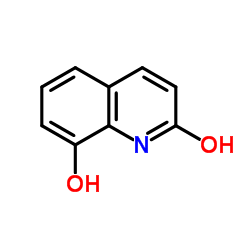2,8-Dihydroxyquinoline

2,8-Dihydroxyquinoline structure
|
Common Name | 2,8-Dihydroxyquinoline | ||
|---|---|---|---|---|
| CAS Number | 15450-76-7 | Molecular Weight | 161.157 | |
| Density | 1.4±0.1 g/cm3 | Boiling Point | 441.7±25.0 °C at 760 mmHg | |
| Molecular Formula | C9H7NO2 | Melting Point | ~290 °C (dec.) | |
| MSDS | USA | Flash Point | 220.9±23.2 °C | |
| Symbol |

GHS07 |
Signal Word | Warning | |
|
Identification of quinoline, carboline and glycinamide compounds in cow milk using HRMS and NMR.
Food Chem. 141(3) , 1888-94, (2013) The aim of this work was to characterise new UV-absorbing compounds (UAC) in cow milk in order to gain an overview of the molecular diversity of the minor bioactive constituents, that could be used to trace animal feed or that potentially affect milk quality.... |
|
|
Antioxidant effects of quinoline alkaloids and 2,4-di-tert-butylphenol isolated from Scolopendra subspinipes.
Biol. Pharm. Bull. 29(4) , 735-9, (2006) The oxidized low-density lipoprotein (ox-LDL) plays a critical role at the early stages of atherosclerosis. Thus, the prevention of LDL-oxidation by antioxidants may arrest the progression of atherosclerosis. Two quinoline alkaloids, 3,8-dihydroxyquinoline (1... |
|
|
Microbiological degradation of quinoline by Pseudomonas stutzeri: the coumarin pathway of quinoline catabolism.
Microbios 59(238) , 47-63, (1989) A Gram-negative, oxidase positive, polar flagellated rod, characterised as Pseudomonas stutzeri, has been isolated from sewage by enrichment culture on quinoline. The organism utilizes quinoline as the sole source of carbon, nitrogen and energy, and liberates... |
|
|
Systems toxicology study of doxorubicin on rats using ultra performance liquid chromatography coupled with mass spectrometry based metabolomics.
Metabolomics 5(4) , 407-418, (2009) A metabolomics-based systems toxicology approach was used to profile the urinary metabolites for the toxicity related processes and pathogenesis induced by doxorubicin (DOX) to rats. Endogenous metabolite profiles were obtained with ultra performance liquid c... |
|
|
The identification of 2,8-quinolinediol in the urine of rats fed a diet containing corn.
J. Biol. Chem. 240(9) , 3682-84, (1965)
|
|
|
Microbial transformation of quinoline by a Pseudomonas sp.
Appl. Environ. Microbiol. 51(6) , 1332-42, (1986) A Pseudomonas sp. isolated from sewage by enrichment culture on quinoline metabolized this substrate by a novel pathway involving 8-hydroxycoumarin. During early growth of the organism on quinoline, 2-hydroxyquinoline accumulated as the intermediate; 8-hydrox... |
|
|
Quinoline biodegradation and its nitrogen transformation pathway by a Pseudomonas sp. strain.
Biodegradation 21(3) , 335-44, (2010) A Pseudomonas sp. strain, which can utilize quinoline as its sole carbon, nitrogen and energy source, was isolated from activated sludge in a coking wastewater treatment plant. Quinoline can be degraded via the 8-hydroxycoumarin pathway. We quantified the fir... |
|
|
Two polymorphs of 8-hydroxycarbostyril: X-ray crystallography, solid-state NMR and DFT calculations. Nieto CI, et al.
J. Mol. Struct. 1008 , 88-94., (2012)
|
|
|
Polymorphism in 8-Hydroxyquinolin-2(1H)-one by X-ray Crystallography, Solid-State NMR and DFT Calculations. Claramunt RM, et al.
Acta Crystallogr. A67 , C816-817, (2011)
|